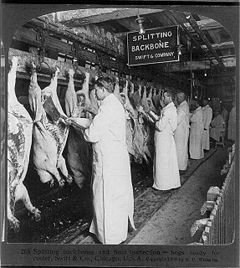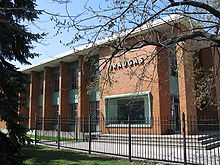- Lithuanians in the Chicago area
-
 The Union Stockyards were at one time a significant employer of Chicago's Lithuanian community. Upton Sinclair's 1906 novel The Jungle, revolves around the life of a Lithuanian immigrant working the Stockyards named Jurgis Rudkus.
The Union Stockyards were at one time a significant employer of Chicago's Lithuanian community. Upton Sinclair's 1906 novel The Jungle, revolves around the life of a Lithuanian immigrant working the Stockyards named Jurgis Rudkus.
Lithuanians in Chicago and the nearby metropolitan area are a prominent group within the "Windy City" whose presence goes back over a hundred years. Today Chicago possesses the largest Lithuanian community outside Lithuania,[1] who have dubbed the city as Little Lithuania, and many Lithuanian-Americans refer to it as the second capital of Lithuania. Lithuanian-Americans from Chicago have had a significant impact on politics in both the United States and Lithuania.
Contents
History
Lithuanians have been documented as arriving in the US since 1918, when Lithuania re-established its independence from Imperial Russia.[1] Although this is the first official record, Lithuanians began arriving at least two decades earlier; however, they were listed as Russian citizens.[1] This is compounded by the fact that, prior to Lithuanian independence, most if not all official documents were written in Russian, Polish or German. Thousands of Lithuanians have since moved to Chicago, providing a good source of labor for the growing city. The Lithuanian community in Chicago was most famously immortalized by Upton Sinclair in his 1906 novel about the treatment of workers in the Chicago stock yards, The Jungle, whose story revolves around telling the life of a Lithuanian immigrant named Jurgis Rudkus.
Distribution
The first and most prominent Lithuanian enclave in Chicago was called "Lithuanian Downtown" which was located along Halsted street in Bridgeport and founded by Lithuanians who settled nearby their Old World neighbors, the Poles, who were located in a Polish Patch in the vicinity of St. Mary of Perpetual Help.[2] It was here that the Lithuanian church of Saint George was founded as the first Lithuanian parish in the Midwest, foreshadowing the prominence that Bridgeport would play as one of the key centers of Lithuanian activity throughout the United States.[3] A large number of the early buildings of this district were built by the first prominent Lithuanian community leader, Antanas Olšauskas (pronounced Ole-shau-skus), circa 1910.[2] Centered on Thirty-third and Halsted, Bridgeport was Chicago's leading Lithuanian neighborhood from the 1890s through the 1950s. Although the numbers of Lithuanians in the area began to fall off in the 1950s, one of Lithuanian Chicago's longtime institutions, Healthy Food Restaurant, still remains on Halsted near Thirty-second street.[2]
Although Lithuanians initially settled in areas adjacent to the ethnic group most familiar from their European homeland, the Poles, a pattern consistent with most other immigrant groups in Chicago, the Lithuanian community today is found all over the Chicago metropolitan area. There have been a number of Chicago neighborhoods in which Lithuanian immigrants have clustered during the 20th century, including Bridgeport, Brighton Park, Marquette Park, and the Back of the Yards. The adjacent near-western suburb of Cicero had an enclave of Lithuanians in the 20th century, especially around St. Anthony's Parish. The most recent wave of immigrants has settled in the Chicago suburbs of Lemont, Darien and Woodridge. There is a small enclave of Lithuanians around the Beverly Shores area in northwest Indiana at the southern coast of Lake Michigan.
Significance
 Valdas Adamkus was an active member of the Lithuanian community in Chicago for decades before becoming President of Lithuania.
Valdas Adamkus was an active member of the Lithuanian community in Chicago for decades before becoming President of Lithuania.
Today "Little Lithuania" is the center of Lithuanian culture in North America. It houses the only museum about Lithuanians in the Western Hemisphere, the Balzekas Museum of Lithuanian Culture, which provides a wealth of information about Lithuania and Lithuanian culture. Little Lithuania has a number of Lithuanian restaurants, bookstores, and other shops. The former president of Lithuania, Valdas Adamkus 1993-2003 and 2004–2009, is a former resident of the Chicago area as well. Chicago is home to the Consulate General of the Republic of Lithuania, and the city's large Lithuanian-American community maintains close ties to what is affectionately called the Motherland. Chicago's Lithuanian heritage is visible in the cityscape through its Lithuanian-named streets such as Lituanica Avenue and Lithuanian Plaza Court as well as an Art Deco monument in Marquette Park commemorating pilots Stasys Girėnas and Steponas Darius who died in the crash of the Lituanica in 1933.
A number of the most architecturally significant churches of the Archdiocese of Chicago were built as national parishes by Lithuanian immigrants such as Holy Cross, Providence of God, and Nativity B.V.M., which is dedicated to our Our Lady of Šiluva or the now demolished St. George's in Bridgeport. Opulently decorated with a proclivity towards Renaissance and Baroque ornamentation, Lithuanian churches were designed in the spirit of the architecture of the Polish-Lithuanian Commonwealth's heyday. Like Chicago's Polish Cathedral's, these churches were statements meant to recall an era when the Grand Duchy of Lithuania spanned from the Baltic to the Black Sea, having been built at a time when Lithuania was under Russian occupation and incorporating Lithuanian imagery in its decor such as the Vytis to invoke pride in Lithuanian culture.
There are many Lithuanian schools built near and in Chicago. Chicago Lithuanian Youth Center (Čikagos Lituanistinė Mokykla), a private school for Lithuanian immigrant children was founded in 1992. Other Lithuanian schools include Maironis in Lemont, Gediminas in Waukegan and Rasa in Naperville. There are also many Lithuanian newspapers circulating around Chicago, like Draugas (Friend), Čikagos Aidas (Echo Chicago), Langas (Window) and Amerikos Lietuvis (Lithuanian American).
Years ago, the Lithuanian Song festival (Dainų Šventė) and Dance Festival (Šokių Šventė) have been held at the now-demolished International Amphitheatre, originally near the Stockyards on the south side of Chicago. More recently, the Song Festival has been held at the UIC Pavilion a couple of times and the Dance Festival held in the suburb of Rosemont, not far from Chicago O'Hare Airport.
The Lithuanian Opera Company of Chicago was founded by Lithuanian emigrants in 1956,[4] and presents operas in Lithuanian. Lithuanian operas were sometimes held at Maria High School in Chicago, a school that has been associated with Lithuanians, and such operas are now sometimes held at Morton East High School in Cicero.
Lithuanian sites in the Chicago area[5]
- Lithuanian World Center (Pasaulio Lietuvių Centras, 14911 127th St.) in Lemont, Illinois - a complex for Lithuanian culture including a sizeable Roman Catholic chapel, Matulaitis Mission, and classrooms for a Lithuanian school on Saturdays, as well as various other facilities.[6]
- Lithuanian Youth Center (Lietuvių Jaunimo Centras, 5620 S. Claremont Ave.) in Chicago's Marquette Park neighborhood on the Chicago south side. At this location, there is a Jesuit Residence for Catholic Fathers and Brothers, the Youth Center, a Roman Catholic chapel, the Čiurlonis Gallery (Čiurlionio Galerija), and the Lithuanian Research and Studies Center, Inc. [Lituanistikos tyrimo ir studijų centras (LTSC)].[7][8] For a photo, see here.
- Consulate General of the Republic of Lithuania in Chicago (Lietuvos Respublikos generalinis konsulatas Čikagoje at 211 E. Ontario St., Suite 1500) on the very near north side of Chicago.
- Ateitis Foundation Center (Ateitininkų Namai, 1380 Castlewood Drive) in Lemont, Illinois - a facility for the Lithuanian youth organization whose members are Ateitininkai.[9] For a photo of the center building, see here.
- Balzekas Museum of Lithuanian Culture (Balzeko lietuvių kultūros muziejus) on Chicago's south side.
- Draugas Publishing House (Draugo Redakcija) not far from the Midway Airport area on the Chicago west side - facility where the publication of the century-old Lithuanian language daily newspaper Draugas takes place.
- St. Casimir Lithuanian Cemetery (Švento Kazimero Kapinės at 4401 W. 111th Street) is a Lithuanian cemetery of the Roman Catholic Archdiocese of Chicago on the edge of the southwest side of Chicago where many deceased Lithuanians are buried.[10]
References
- ^ a b c Čikagos aidas. The Lithuanian Market. Retrieved on 2008-09-04
- ^ a b c http://www.ahsd25.k12.il.us/curriculum%20Info/Neighborhoods/bridgeport1.htm
- ^ http://www.ahsd25.k12.il.us/curriculum%20Info/Neighborhoods/bridgeport2.htm
- ^ "About the Lithuanian Opera Company, Inc. in Chicago". Lithuanian Opera Co.. http://www.lithoperachicago.org/. Retrieved 2006-09-14.
- ^ Jaunimas.us - adresai
- ^ Pasaulio Lietuviu Centras | Lithuanian World Center |
- ^ BalticJesuit
- ^ LTSC - Lituanistikos tyrimo ir studiju centras, Chicago, IL
- ^ Ateitininku Namai
- ^ Lithuanian Parishes of the Roman Catholic Diocese in America
External links
City of Chicago Architecture · Beaches · Climate · Colleges and Universities · Community areas · Culture · Demographics · Economy · Flag · Freeways · Geography · Government · History · Landmarks · Literature · Media · Music · Neighborhoods · Parks · Public schools · Skyscrapers · Sports · Theatre · Transportation
 Category ·
Category ·  PortalCategories:
PortalCategories:- Lithuanian emigration
- Lithuanian American history
- Culture of Chicago, Illinois
Wikimedia Foundation. 2010.

